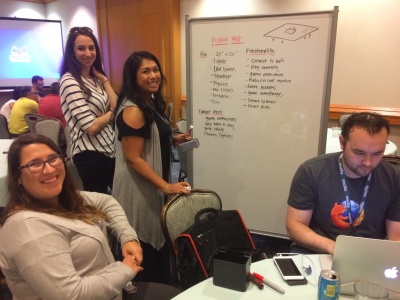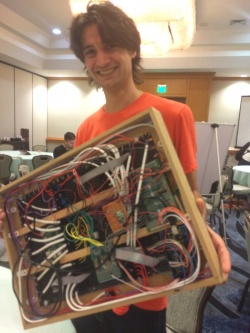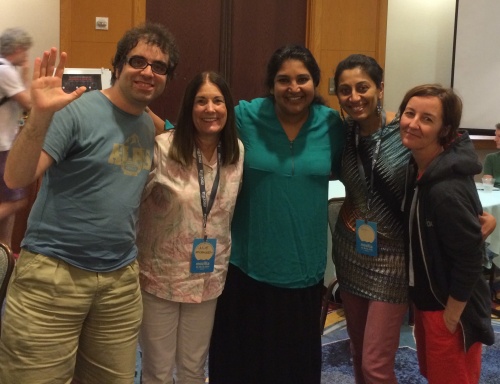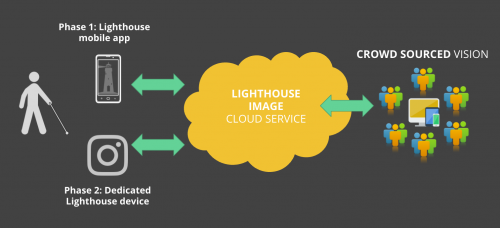<< Connected Devices Weekly Updates Home
| Program
|
Passed Gate
|
Status
|
Notes
|
| Project Sensor Web
|
Cindy/Jean
|
Gate 1
|
On Target
|
This week's update
- Engineering team on track towards doing Sprint 3 demo Friday, Dec 16 (last dev sprint 2016):
- Firmware: Collect real data from sensors, transmit to cloud
- Cloud: SensorThings API, receive and store sensor readings
- Web: Ability to browse collected sensor readings
- Note: BLE setup, firmware updates are not part of December commitment
Upcoming Tasks
- Dec 15 - Perform Rapid Risk Analysis (RRA) review with Enterprise Security
- Starting RFP process for vendor selection on Tooling manufacturer
Software Schedule - Dec 16 Milestone: (ON TRACK)
- Firmware: Collect real data from sensors, transmit to cloud
- Cloud: SensorThings API, receive and store sensor readings
- Web: Ability to browse collected sensor readings
Hardware Schedule (ON TRACK)
- Dec 19 Development boards ready for Mozilla
|
| Project_Haiku
|
Liz/Mahe
|
Gate 1
|
On Target
|
- Gate 1 Passed
- Putting together the hardware components schema
- Working on reaching external resources (ID/EE) to get going on sow/legal work
|
| Platform and Tools
|
Sandip/Nicole/Mahe
|
N/A
|
On Target
|
- Team is going through a second refinement of the Architecture Proposal.
- Team met with internal reviewers in Hawaii to go through feedback and answer questions
- Platform/Product alignment kicked off with individual architecture and extraction reviews
- Team is reviewing 2017 goal planning that we are presenting to leadership tomorrow.
|
| Voice Platform - Deep Speech
|
Sandip/Nicole
|
N/A
|
On Target
|
Project VoiceBank at Hawaii
- 78 contributors
- 627 sentences submitted
Final Update: Has been officially transitioned to Emerging Technologies
|
| Project Magnet
|
David/Maria
|
Gate 0
|
On Target
|
- Checkin December 21 with PIB with User Study results and Design Direction
- Scheduling a date for Gate 1 review in early January
- Overall Hawaii work week was very useful to the team - where we now have a stronger design direction, user journey, and stories beyond the last release.
- User Validation Study
- Ran week before Hawaii with 9 people interviewed and testing a mockup
- Overall had good results and validated hypothesis, but also greatly influenced our design direction and discussion during Work Week.
- Problem Hypotheses: People have FOMO about knowledge and experiences in the world around them, existing solutions provide useful practical information but are geared towards consumption of goods and services, not gaining knowledge or experiences
- Experience Strategy: Provide a sense of adventure and progress in the experience, combine the digital and physical worlds in a unique and compelling way, provide visually engaging stories and encourage user-generated content to add value.
- Problem-solution fit - does our concept have value? We think it does. We are taking stories a bit deeper, and with continuity of a story across different locations. We found that our solution seems very unique and compelling to people who tried it. Can't get the type of content we have elsewhere.
- Product
- New User Stories in progress based on a User Journey we worked on in Hawaii. Will release these after some team review.
- Development
- Released the new iOS version right before Hawaii. Available in App Store and Google Play. Supports over 1100 deployed points of interest in London and some in San Francisco.
- Working on technical architecture document for a more 'magazine' style interface.
- UX
- Working on new mockups that will support the design direction.
|
| HomeWeb
|
Ben/Mahe
|
Gate 0
|
On Target
|

In Hawaii the team worked on:
- Deep dive into research done so far
- Ideation around the customer experience
- A hardware strategy
We came up with three high level design concepts for the customer experience:
- Trusted Circle - share access to your home monitoring system with a trusted circle of friends using time-limited URLs
- Network Health Monitoring - Monitor not only your home health, but your home network health as well
- Thing Directory - A community-curated directory of Things that you can use with HomeWeb (and ultimately Mozilla's IoT platform).
On the hardware side we agreed to start implementing the software experience on Raspberry Pi so we can start to get out early software releases to the community and test the user experience without being blocked on the hardware evaluation.
Q1 2017 plan:
- A UX spec and working prototype of basic use cases + sharing feature
- User research into new user experience areas (particularly network health monitoring)
- Pre-order test to test a specific product proposition with UI and hardware mockups
- Continued hardware evaluation
- Gate 1 at end of Q1
|
| GameON!
|
Candice/Julie
|
Gate 0
|
Moved to Backlog
|
Hawaii Work Week Efforts
- Worked on schematic and pcb for spinner and board
- Defined MVP for post Gate 0 phase
- Developed questions to answer in user studies
- Worked on dev tool kit for contributor game development


Conclusions
- GameON! shows potential in providing new and exciting functionality and interactions that don't currently exist in the target market.
- Connected Devices has a limited number of resources and cannot continue to carry forward every project that shows promise.
- Decision was made to move GameON! into the backlog.
|
| Lighthouse
|
Preeti/Julie
|
Gate 1
|
On Target
|
Hawaii Work Week Progress
- Passed Gate 1!
- Finished high level planning for post-Gate 1 Phase 1
- Conducted design and interaction brainstorming
- Engaged accessibility team

Next Steps (Build-Test-Learn Iterations)
Two phases
- Phase 1: Mobile App to be completed by end of Q1, 2017, with focus in US (other countries TBD)
- Phase 2: Dedicated Device app to be completed in Q4, 2017, in English and Spanish and possibility to extend others to MozCommunity

Industrial Design Concepts
- Wearable
- Handheld
- Clip On
Phase 1, Sprint 1 Planning
- IOS App Dev Ramp-up
- IOS App Skeleton
- Draft Requirements Doc
- Draft UX App Interaction Design
|
| Market Developments Update
|
Irina
|
|
|
- Microsoft
- Microsoft is planning to allow fridges, toasters, thermostats, and other Internet of Things (IoT) devices to access Cortana. The software giant is bringing Cortana to IoT devices with its Windows 10 Creators Update, due in March 2017. "This will enable you to build devices with displays, so you get that immersive Cortana experience,” explains Microsoft program manager Carla Forester. “Any kind of smart device with a screen can now take advantage of Cortana.
- Microsoft announced the Cortana Skills Kit and Cortana Devices SDK. The Cortana Skills Kit is designed to help developers reach the growing audience of 145 million Cortana users, helping users get things done while driving discovery and engagement across platforms: Windows, Android, iOS, Xbox and new Cortana-powered devices. The Cortana Devices SDK will allow OEMs and ODMs to create smart devices. The Cortana Skills Kit will allow developers to leverage bots created with the Microsoft Bot Framework and publish them to Cortana as a new skill, to integrate their web services as skills and to repurpose code from their existing Alexa skills to create Cortana skills. Cortana Devices SDK makes Cortana available to all OEMs and ODMs to build smarter devices on all platforms.
- Microsoft announced a new Microsoft Ventures fund dedicated to artificial intelligence (AI) investments. The fund, part of the company’s investment arm that launched in May, will back startups developing AI technology and includes Element AI, a Montreal-based incubator that helps other companies embrace AI. The global market for AI systems will reach $70 billion in 2020, up from $14.9 billion in 2014, Bank of America Merrill Lynch predicted last year. These AI systems span a broad category of solutions, including digital assistants, machine-learning algorithms that identify objects in images and detect cybercrime, and software that helps self-driving cars and drones avoid obstacles.
- Microsoft is partnering with audio giant Harman Kardon to debut what appears to be a cylindrical speaker device equipped with Cortana in 2017. The video teaser shows a disembodied voice using the "Hey Cortana" command to play music through the speaker, while the top of the device shows what looks like a circular display glowing with blue light. Microsoft says this is just one of the hardware solutions to come equipped with Cortana next year.
- Intel is partnering with Microsoft through Project Evo to "push the boundaries of a personal computer's capabilities in the near future" Technologies under development include far-field speech and wake-on-voice enabled through Cortana, biometrics and voice authentication in Windows Hello, spacial audio, and HDR support for gaming. Project Evo -- particularly its expanded use of Cortana -- invites comparisons to the digital assistant tools found in Amazon Echo and Google Home. Though their capabilities differ, each uses voice communications to interact with the automated home.
- Microsoft is rumored to be preparing a HomeHub feature for Windows 10
- Google:
- Google announced that it's opening up its voice-activated Assistant to third-party developers. Initially, developers will be able to build "conversation actions" — which enable consumers to interact with a company’s chatbot — through Assistant on Google Home. The company plans to eventually extend the Assistant integration to its other products, including the Pixel and Allo chat app. Direct actions — which don’t require a conversation, such as turning on the lights or playing a song — will still require a partnership with Google. Two of the three most important reasons for using voice assistants, according to a GlobalWebIndex survey, are that it's quicker and easier than using the web or apps.
- Qualcomm said it will work with Google to combine Android Things, an Internet of things operating system, and its Snapdragon processor. Qualcomm said the collaboration with Google will focus on developing both "consumer and industrial applications."
- IoT platforms:
- A head-to-head comparison of Amazon AWS for IoT and Microsoft's Azure IoT platform.
|
| Other Announcements / Questions
|
--
|
--
|
|




